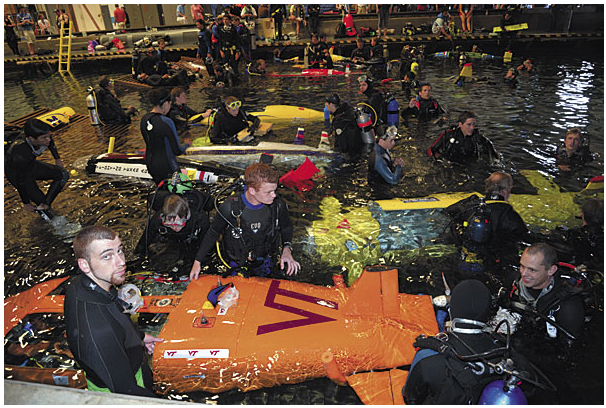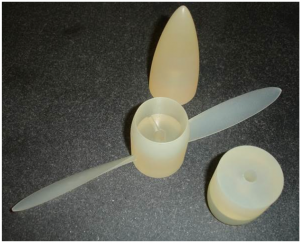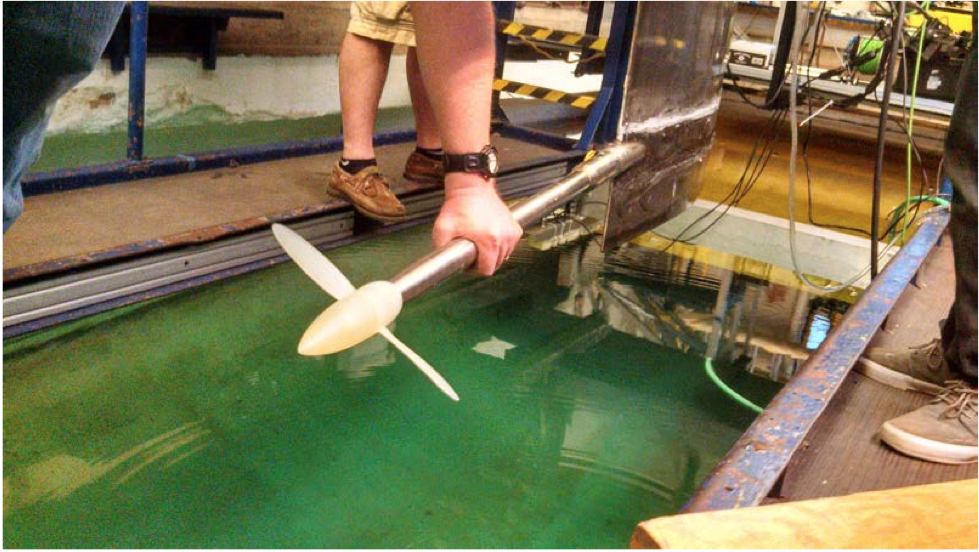The first human powered international submarine race was held in 1989 in Florida and had 17 crafts competing. For this competition each team develops a one or two person, “wet” submarine that they have designed from scratch, which relies upon novel techniques for propulsion and guidance. The race consists of passage through a 10 m section of an indoor channel that the U.S. Navy uses to test their new ship designs. The competition lasts for five days and each team may run their submarine through the course for as many runs as time allows.
 The University of Michigan Human Powered Submarine team competes in this race every other year in its mission to increase public awareness of underwater technology. During the creation of their latest entry to this competition, the team ran into some difficulty in the creation of the submersible’s propeller blade. Specifically, the team was having difficulty with the conversion of a point cloud file to one that they could use to direct the cutter path on a CNC machine.
The University of Michigan Human Powered Submarine team competes in this race every other year in its mission to increase public awareness of underwater technology. During the creation of their latest entry to this competition, the team ran into some difficulty in the creation of the submersible’s propeller blade. Specifically, the team was having difficulty with the conversion of a point cloud file to one that they could use to direct the cutter path on a CNC machine.
 Coincidentally, the brother of a team member was attending an open house at Burton Precision in Grand Rapids Michigan and after the 3-D printing demonstration approached Burton’s vice president Rick Kerkstra. He outlined some of the difficulties that he had learned of from his brother and Kerkstra gave him a business card. To Kerkstra’s surprise, Jeremy Werner of the University of Michigan’s Naval Architecture and Marine Engineering Department called to discuss the problem they were having.
Coincidentally, the brother of a team member was attending an open house at Burton Precision in Grand Rapids Michigan and after the 3-D printing demonstration approached Burton’s vice president Rick Kerkstra. He outlined some of the difficulties that he had learned of from his brother and Kerkstra gave him a business card. To Kerkstra’s surprise, Jeremy Werner of the University of Michigan’s Naval Architecture and Marine Engineering Department called to discuss the problem they were having.
“I think Jeremy and I had about 14 emails the first week so it wasn’t as simple as a file conversion. It usually never is. He sent me an STL file that I read into Geomagic® Studio Software in an attempt to create a nurbs surface. We were dealing with low-resolution files and an edge on the blade that was giving the surface creation fits! Jeremy did four or five rewrites before we had a file we could use.”
The collaboration didn’t end there, however. Once Kerkstra was able to provide a usable file he inquired about the possibilities of also doing the 3D printing. This required a great deal more conversation between Burton Precision and the human powered submarine team. Kerkstra explained the nature of their collaboration:
“We had further discussions about strength of material, testing using the scale version, and overall functionality of the printed part. The first surface files that we provided failed the initial testing in their simulator because the blade thickness was too thin. That was enlarged and the thicker blade passed. We 3D printed the propeller on a 3D Systems ProJet 3500 HDMax printer in a plastic material called Crystal.”
 This type of interaction requires that Burton Precision not only provide services but also engage in the education of its clients. This was a perfect fit for the project goals and left the University of Michigan team impressed with the possibilities for 3-D printing. Kerkstra’s hope to continue the relationship between Burton Precision and the University of Michigan seems certain as team leader Jeremy Werner discussed his satisfaction with their contribution:
This type of interaction requires that Burton Precision not only provide services but also engage in the education of its clients. This was a perfect fit for the project goals and left the University of Michigan team impressed with the possibilities for 3-D printing. Kerkstra’s hope to continue the relationship between Burton Precision and the University of Michigan seems certain as team leader Jeremy Werner discussed his satisfaction with their contribution:
“Burton Precision became a key player in providing a hands-on learning experience for me and all the team members involved in the scale model propeller test. This kind of out of the classroom training is at the core of our team’s mission statement, and everyone from outside U of M who contribute to that deserves special recognition.”
In case you were wondering, back in April the 3D printed propeller was tested for the very first time,and it worked nearly perfectly. The possibilities of utilizing 3D printing to make custom props for boats, planes and submarines could give designers an entirely new tool for their creations. Let’s hear your thoughts on this story in the 3D printed submarine propeller forum thread on 3DPB.com.
Subscribe to Our Email Newsletter
Stay up-to-date on all the latest news from the 3D printing industry and receive information and offers from third party vendors.
You May Also Like
IperionX Inks 10-Year Deal with Wisconsin Manufacturer for 80 Metric Tons of Titanium Per Year
IperionX, the Charlotte-based supplier of sustainable titanium powders used for additive manufacturing (AM) and metal injection molding (MIM), has signed a ten-year deal with United Stars, a group of industrial...
Gastronology Launches Industrial Production of 3D Printed Food for Dysphagia Patients
Food 3D printing has, in many ways, been an additive manufacturing (AM) segment looking for the right business case. While some applications are beautiful and others may or may not...
Lockheed Martin Leads $3M Investment in Q5D’s Electronics 3D Printing System
Q5D, an original equipment manufacturer (OEM) of robotic arm, hybrid additive manufacturing (AM) systems used for wire harness production, has closed a $3 million investment round. The investment arm of...
3D Printing News Briefs, April 6, 2024: Depowdering, Cybertruck Door Handles, & More
In today’s 3D Printing News Briefs, ioTech’s digital manufacturing CLAD technology is opening up opportunities for microelectronics and additive manufacturing. Hexagon and Raytheon Technologies commercially released the Simufact Additive Process...































